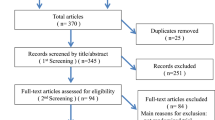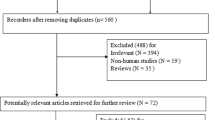Abstract
Previous primary studies have explored the association between blood pressure (BP) and mortality in ambulatory heart failure (HF) patients reporting varying and contrasting associations. The aim is to determine the pooled BP prognostic value and explore potential reasons for between-study inconsistency. We searched Medline, Cochrane, EMBASE and CINAHL from January 2005 to October 2018 for studies with ≥ 50 events (mortality and/or hospitalization) and included BP in a multivariable model in ambulatory HF patients. We pooled hazard ratios (random effects model) for systolic BP (SBP) or diastolic BP (DBP) effect on mortality and/or hospitalization risk. We used a priori defined sub-group analyses to explore heterogeneity and GRADE approach to assess the certainty of the evidence. Seventy-one eligible articles (239,467 screened) at low to moderate risk of bias included 235,752 participants. Higher SBP was associated with reduced all-cause mortality (HR 0.93, 95%CI 0.91–0.95, I2 = 87.13%, moderate certainty), all-cause hospitalization events (HR 0.91, 95%CI 0.88–0.93, I2 = 44.4%, high certainty) and their composite endpoint (HR 0.93 per 10 mmHg, 95%CI 0.91–0.94, I2 = 86.3%, high certainty). DBP did not demonstrate a statistically significant effect for all outcomes. The association strength was significantly weaker in studies following patients with either LVEF > 40%, higher average SBP (> 130 mmHg), increasing age and diabetes. All other a priori subgroup hypotheses did not explain between study differences. Higher ambulatory SBP is associated with reduced risk of all-cause mortality and hospitalization. Patients with lower BP and reduced LVEF are in a high-risk group of developing adverse events with moderate certainty of evidence.



Similar content being viewed by others
References
Savarese G, Lund LH (2017) Global public health burden of heart failure. Card Fail Rev 3:7–11
Rahimi K, Bennett D, Conrad N et al (2014) Risk prediction in patients with heart failure: a systematic review and analysis. JACC Heart Fail 2:440–446
Bilchick KC, Stukenborg GJ, Kamath S et al (2012) Prediction of mortality in clinical practice for medicare patients undergoing defibrillator implantation for primary prevention of sudden cardiac death. J Am Coll Cardiol 60:1647–1655
Frankenstein L, Goode K, Ingle L et al (2011) Derivation and validation of a simple clinical risk-model in heart failure based on 6 minute walk test performance and NT-proBNP status—do we need specificity for sex and beta-blockers? Int J Cardiol 147:74–78
Levy WC, Mozaffarian D, Linker DT et al (2006) The Seattle Heart Failure Model: prediction of survival in heart failure. Circulation 113:1424–1433
Guder G, Frantz S, Bauersachs J et al (2009) Reverse epidemiology in systolic and nonsystolic heart failure: cumulative prognostic benefit of classical cardiovascular risk factors. Circ Heart Fail 2:563–571
Meta-analysis Global Group in Chronic Heart F (2012) The survival of patients with heart failure with preserved or reduced left ventricular ejection fraction: an individual patient data meta-analysis. Eur Heart J 33:1750–7.
Raphael CE, Whinnett ZI, Davies JE et al (2009) Quantifying the paradoxical effect of higher systolic blood pressure on mortality in chronic heart failure. Heart 95:56–62
Shadman R, Poole JE, Dardas TF et al (2015) A novel method to predict the proportional risk of sudden cardiac death in heart failure: derivation of the Seattle Proportional Risk Model. Heart Rhythm 12:2069–2077
Mathew J, Wittes J, McSherry F et al (2005) Racial differences in outcome and treatment effect in congestive heart failure. Am Heart J 150:968–976
Bohm M, Young R, Jhund PS et al (2017) Systolic blood pressure, cardiovascular outcomes and efficacy and safety of sacubitril/valsartan [LCZ696] in patients with chronic heart failure and reduced ejection fraction: results from PARADIGM-HF. Eur Heart J 38:1132–1143
Schünemann H, Brożek J, Guyatt G et al (2017) GRADE handbook for grading quality of evidence and strength of recommendations. Updated October 2013. The GRADE Working Group, 2013.
Ather S, Chan W, Chillar A et al (2011) Association of systolic blood pressure with mortality in patients with heart failure with reduced ejection fraction: a complex relationship. Am Heart J 161:567–573
Messerli FH, Rimoldi SF, Bangalore S (2017) The transition from hypertension to heart failure: contemporary update. JACC Heart Fail 5:543–551
Pinho-Gomes AC, Rahimi K (2019) Management of blood pressure in heart failure. Heart 105:589–595
White M, Desai RV, Guichard JL et al (2012) Bucindolol, systolic blood pressure, and outcomes in systolic heart failure: a prespecified post hoc analysis of BEST. Can J Cardiol 28:354–359
Pocock SJ, Ariti CA, McMurray JJ et al (2013) Predicting survival in heart failure: a risk score based on 39 372 patients from 30 studies. Eur Heart J 34:1404–1413
de Boer IH, Bangalore S, Benetos A et al (2017) Diabetes and hypertension: a position statement by the American Diabetes Association. Diabetes Care 40:1273–1284
Franklin SS, Gustin Wt, Wong ND et al (1997) Hemodynamic patterns of age-related changes in blood pressure. The Framingham Heart Study. Circulation 96:308–15
Greenwald SE (2007) Ageing of the conduit arteries. J Pathol 211:157–172
McEniery CM, McDonnell BJ, So A et al (2009) Aortic calcification is associated with aortic stiffness and isolated systolic hypertension in healthy individuals. Hypertension 53:524–531
Mercier N, El Hadri K, Osborne-Pellegrin M et al (2007) Modifications of arterial phenotype in response to amine oxidase inhibition by semicarbazide. Hypertension 50:234–241
Payne RA, Wilkinson IB, Webb DJ (2010) Arterial stiffness and hypertension: emerging concepts. Hypertension 55:9–14
Wallace SM, Yasmin, McEniery CM et al (2007) Isolated systolic hypertension is characterized by increased aortic stiffness and endothelial dysfunction. Hypertension 50:228–33
Pinho-Gomes AC, Azevedo L, Bidel Z et al (2019) Effects of blood pressure-lowering drugs in heart failure: a systematic review and meta-analysis of randomized controlled trials. J Hypertens 37:1757–1767
Hemila H, Friedrich JO (2019) Many continuous variables should be analyzed using the relative scale: a case study of beta2-agonists for preventing exercise-induced bronchoconstriction. Syst Rev 8:282
Higgins JP, Thompson SG, Spiegelhalter DJ (2009) A re-evaluation of random-effects meta-analysis. J R Stat Soc Ser A Stat Soc 172:137–159
Acknowledgements
The authors thank Derrick Chang for his invaluable help performing citation screening.
Author information
Authors and Affiliations
Contributions
Conception and design: FF, HR, ACA. Drafting the article: MHL, ML. Revising the article: all authors. Provided intellectually content of critical importance to the work described: all authors. Final approval of the version to be published: all authors.
Corresponding author
Ethics declarations
Conflict of interest
The authors declare that they have no conflict of interest.
Additional information
Publisher’s Note
Springer Nature remains neutral with regard to jurisdictional claims in published maps and institutional affiliations.
Supplementary information
Below is the link to the electronic supplementary material.
Rights and permissions
About this article
Cite this article
Lee, M.H., Leda, M., Buchan, T. et al. Prognostic value of blood pressure in ambulatory heart failure: a meta-analysis and systematic review. Ambulatory blood pressure predicts heart failure prognosis. Heart Fail Rev 27, 455–464 (2022). https://doi.org/10.1007/s10741-021-10086-w
Accepted:
Published:
Issue Date:
DOI: https://doi.org/10.1007/s10741-021-10086-w




